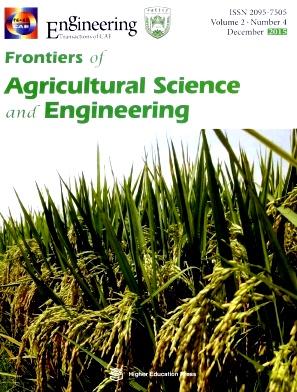WHEAT STRIPE RUST AND INTEGRATION OF SUSTAINABLE CONTROL STRATEGIES IN CHINA
IF 2.8
4区 农林科学
Q1 AGRONOMY
引用次数: 16
Abstract
Stripe (yellow) rust caused by Puccinia striiformis f. sp. tritici occurs in almost all wheat-producing regions of the world. Severe countrywide epidemics in China have caused substantial yield losses. Growing resistant cultivars is the best strategy to control this disease but the pathogen can overcome resistance in wheat cultivars. The high variation in the virulence of the pathogen combined with the large areas of susceptible wheat cultivars enables the pathogen population to increase rapidly and disperse over long distances under favorable environmental conditions, resulting in severe pandemics within cropping seasons. Current stripe rust control measures are based on many years of research including the underlying epidemiology regarding year-to-year survival of the pathogen, pathways of pathogen dispersal within seasons and years, the role of P. striiformis sexual hybridization, the use of resistance sources in breeding programs, and year-round surveillance of national wheat crops that are present in different parts of the country throughout the year. All these strategies depend on accurate prediction of epidemics, more precise use of fungicides to meet national requirements and better deployment of resistance genes. New ideas with potential application in sustainable protection of stripe rust include negative regulatory gene editing, resistance gene overexpression and biological control based on microbiomes. © The Author(s) 2021. Published by Higher Education Press. This is an open access article under the CC BY license (http://creativecommons.org/licenses/by/4.0)中国小麦条锈病及其综合可持续防治策略
小麦条锈病(黄锈病)由小麦条锈病引起,发生在世界上几乎所有的小麦产区。中国严重的全国性流行病造成了巨大的产量损失。培育抗病品种是控制该病的最佳策略,但病原菌可以克服小麦品种的抗性。病原菌毒力的高度变异,加上大面积的易感小麦品种,使病原菌种群在有利的环境条件下迅速增加并远距离扩散,在种植季节造成严重的流行病。目前的条锈病防治措施是基于多年的研究,包括病原体逐年生存的潜在流行病学,病原体在季节和年份中的传播途径,条纹状假单胞虫性杂交的作用,育种计划中抗性来源的使用,以及全年对全国不同地区小麦作物的全年监测。所有这些战略都取决于对流行病的准确预测、更精确地使用杀菌剂以满足国家要求以及更好地部署抗性基因。负调控基因编辑、抗性基因过表达和基于微生物组的生物防治是条子锈病可持续保护的新思路。©作者2021。高等教育出版社出版。这是一篇基于CC BY许可(http://creativecommons.org/licenses/by/4.0)的开放获取文章。
本文章由计算机程序翻译,如有差异,请以英文原文为准。
求助全文
约1分钟内获得全文
求助全文
来源期刊
CiteScore
5.10
自引率
2.70%
发文量
33
期刊介绍:
Frontiers of Agricultural Science and Engineering (FASE) is an international journal for research on agricultural science and engineering. The journal’s aim is to report advanced and innovative scientific proceedings in agricultural field including Crop Science, Agricultural Biotechnology, Horticulture, Plant Protection, Agricultural Engineering, Forestry Engineering, Agricultural Resources, Animal Husbandry and Veterinary Medicine, Applied Ecology, Forestry and Fisheries. FASE is committed to provide a high level scientific and professional forum for researchers worldwide to publish their original findings and to utilize these novel findings to benefit the society.

 求助内容:
求助内容: 应助结果提醒方式:
应助结果提醒方式:


